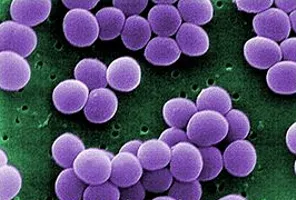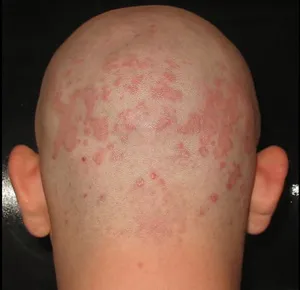
What Is Scalp Folliculitis And Does It Cause Hair Loss?
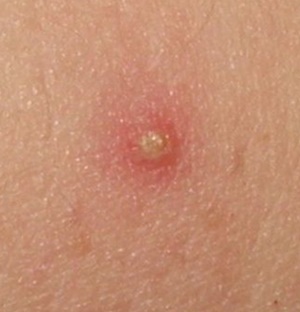 Folliculitis, single lesion - - Own work - Wikipedia
Folliculitis, single lesion - - Own work - WikipediaFolliculitis is the infection and inflammation in one or more pockets where hair follicles grow.
The condition may occur anywhere on either hair-covered or uncovered skin.
A type of acne rash which initially appears around the hair follicles. They look like individual pimples which form a white tip or head.
The acne-like bumps appear on the face, chest, back, arms, legs, buttocks, scalp, or head.
Although acne can often involve superficial inflammation of some hair follicles, the condition of those follicles is usually not persistent, chronic, or progressive.
What Is Scalp Folliculitis?
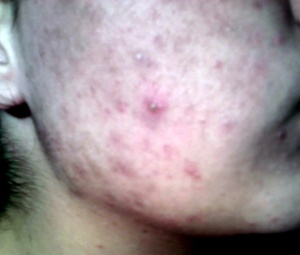 Pimples on a 16-year-old face - Diariodaj - Personal file - Wikipedia
Pimples on a 16-year-old face - Diariodaj - Personal file - WikipediaMild cases often clear up on their own. Antibiotics or other drugs may be needed for severe cases.
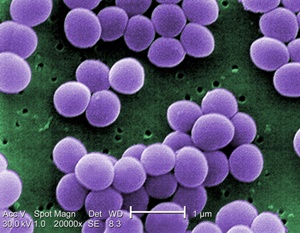 Under a very high magnification of 20,000x, this scanning electron micrograph (SEM) shows a strain of Staphylococcus aureus bacteria taken from a vancomycin intermediate-resistant culture (VISA)
Under a very high magnification of 20,000x, this scanning electron micrograph (SEM) shows a strain of Staphylococcus aureus bacteria taken from a vancomycin intermediate-resistant culture (VISA)What Is Scalp Folliculitis?
That term is usually reserved for the separate disease entities comprising infected and inflamed hair follicles with causes other than acne.
It is a common skin condition that happens when hair follicles become inflamed. It's often caused by an infection with bacteria.
At first, it may look like small pimples around the tiny pockets where each hair grows (hair follicles). The condition can be itchy, sore, and embarrassing.
Infectious Folliculitis
When scalp or other types of Folliculitis becomes infected, it's caused by bacterial, viral, fungal, or parasitic etiology.
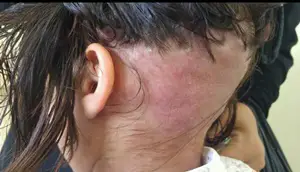 Folliculitis decalvans
Folliculitis decalvansScalp Folliculitis Complications
This condition can develop into a more severe skin condition, such as cellulitis or abscess.
Most carbuncles, boils, and other cases of Folliculitis are infected with Staphylococcus aureus.
Folliculitis starts with the introduction of a skin pathogen to a hair follicle.
Hair follicles can also be damaged by friction from clothing, an insect bite, blockage of the follicle, shaving, or braids that are very tight and too close to the scalp.
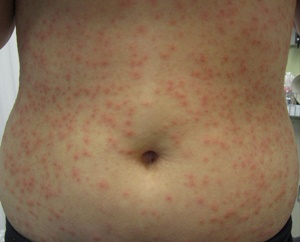 Hot tub folliculitis - James Heilman, MD - Own work
Hot tub folliculitis - James Heilman, MD - Own workThe damaged follicles are then infected by Staphylococcus spp. Folliculitis can affect people of all ages.
Iron deficiency anemia is sometimes associated with chronic cases.
Bacterial Folliculitis
Staphylococcus Aureus Folliculity and Barber's Itche are both bacterial in nature.
Staphylococcus Aureus Folliculitis
Hot-tub folliculitis is caused by the bacterium Pseudomonas aeruginosa. The Folliculitis usually occurs after sitting in a hot tub that was not properly cleaned before use.
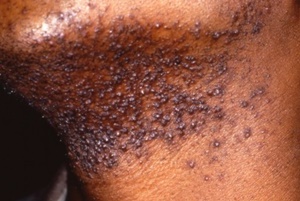 Picture of Pseudofolliculitis Barbae (PFB) from Madigan Army Medical Center Dermatology and SAUSHEC Dermatology teaching file.
Picture of Pseudofolliculitis Barbae (PFB) from Madigan Army Medical Center Dermatology and SAUSHEC Dermatology teaching file.Symptoms are found around the body parts that sit in the hot tub. This includes legs, hips, chest, buttocks, and surrounding areas.
These are amplified around regions covered by wet clothing, such as bathing suits.
Barber's Itch
Sycosis Vulgaris, sycosis barbae is known as barber's itch. It's a staphylococcal infection of the hair follicles in the bearded area of the face,
It usually appears on the upper lip. Shaving aggravates the condition. Gram-negative Folliculitis may occur after prolonged acne treatment with antibiotics.
Fungal Folliculitis
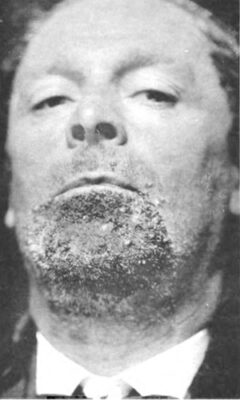 George Henry Fox - Fox, George Henry (1886) Photographic illustrations of skin diseases.
George Henry Fox - Fox, George Henry (1886) Photographic illustrations of skin diseases.Tinea barbae is similar to a barber's itch. The infection is caused by the fungus T. rubrum.
Malassezia folliculitis, formerly Pityrosporum folliculitis, is caused by yeasts of the Malassezia genus. It's part of the fungus kingdom.
Mites
Demodex Folliculitis is usually caused by an overgrowth of Demodex folliculorum. It's a mite that lives in human hair follicles.
Although most people with D. folliculorurm have no symptoms, the mite can reproduce excessively.
This is true in people with oily scalps.
Viral Folliculitis
Herpetic folliculitis is rarer. It may occur when herpes simplex virus infection spreads to nearby hair follicles. It appears in groups or clusters.
Noninfectious Folliculitis
Folliculitis refers to inflammation of the hair follicle. It can be infectious or noninfectious.
It's most commonly the result of follicular trauma, inflammation, or occlusion.
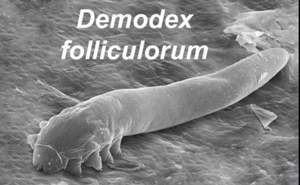 Demodex folliculorum SEM crop
Demodex folliculorum SEM cropNoninfectious Folliculitis may occur as a result of the following:
- Pseudofolliculitis barbae occurs when hair curves back into the skin, causing inflammation.
- Eosinophilic Folliculitis may appear in persons with impaired immune systems.
- Folliculitis decalvans or tufted Folliculitis affects the scalp. Several hairs arise from the same hair follicle.
- Scarring and permanent hair loss may follow. The cause is unknown.
- Folliculitis keloidalis scarring on the nape of the neck is most common among males with curly hair.
- Oil folliculitis is inflammation of hair follicles due to exposure to various oils or creams. They typically occur on the forearms or thighs.It is common in refinery workers, road workers, mechanics, and sheep shearers. It may also be caused by makeup.
- Malignancy may also be represented by recalcitrant cases.
Permanent Hair Loss May Occur
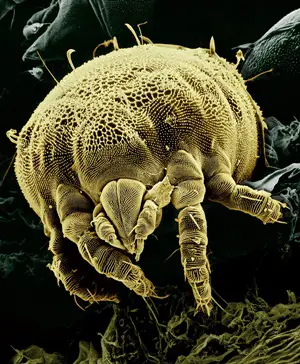 Photo by Eric Erbe; digital colorization by Chris Pooley. Edited by Fir0002 - This image was released by the Agricultural Research Service, the research agency of the United States Department of Agriculture, with the ID K9077-22.
Photo by Eric Erbe; digital colorization by Chris Pooley. Edited by Fir0002 - This image was released by the Agricultural Research Service, the research agency of the United States Department of Agriculture, with the ID K9077-22.Left untreated, severe infections may cause permanent hair loss. Certain types of Folliculitis are known as hot tub rash or barber's itch.
This drug is famous for having severe side effects.
Accutane is known for causing Telogen Effluvium (TE) or triggering Androgenetic Alopecia (AGA). It may impact the liver.
Other possible side effects may include a persistent rash on the entire body. Chronic stomach problems may develop.
Do-It-Yourself Remedies for Scalp Folliculitis
Mild Folliculitis may heal without scarring. Basic self-care is often helpful.
If Folliculitis is left untreated or worsens, it can lead to permanent scarring and hair loss.
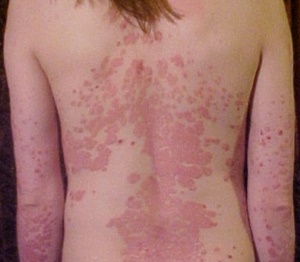 Psoriasis_on_back: User: The Wednesday Island (of the English Wikipedia) derivative work: James Heilman, MD Wikipedia
Psoriasis_on_back: User: The Wednesday Island (of the English Wikipedia) derivative work: James Heilman, MD WikipediaFor serious or chronic cases, consider the following DIY remedies:
- Wash daily with antibacterial soap. Scalp folliculitis is commonly found right at the hairline.It may spread over the entire scalp.
- Use warm compresses to encourage pus drainage, stop itching and provide soothing relief.
- Apply over-the-counter topical antibiotic ointments made with Tea Tree essential oils.
- Use drugstore creams to soothe inflammation.
- Try an anti-fungal shampoo. Allow the formula to soak into the scalp for 5-10 minutes.
- Evaluate nutrition. Sugar and complex carbs may feed the infections. Look at switching to a plant-based diet.
- Keep bedsheets, pillowcases, and towels clean to avoid reinfection.
Summary - What Is Scalp Folliculitis, And Does It Cause Hair Loss?
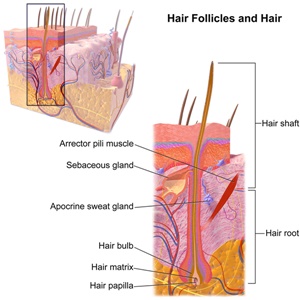 Scalp Folliculitis is the infection and inflammation of one or more hair follicles. The condition occurs on the hairline or scalp.
Scalp Folliculitis is the infection and inflammation of one or more hair follicles. The condition occurs on the hairline or scalp.
It may also be caused by viruses, fungi, parasites, medications, or physical injury. Sometimes the cause isn't known.
Scalp folliculitis may initially appear to be a mild case of pimples, but It can worsen.
If left untreated, it can become persistent and chronic. It can lead to scarring and, eventually, hair loss.
Best wishes.
References
Social Media Network Information
Please follow us on Twitter at: https://Twitter.com/HairBoutique. I look forward to meeting new people from all walks of Twitter and learning from their Tweets.


